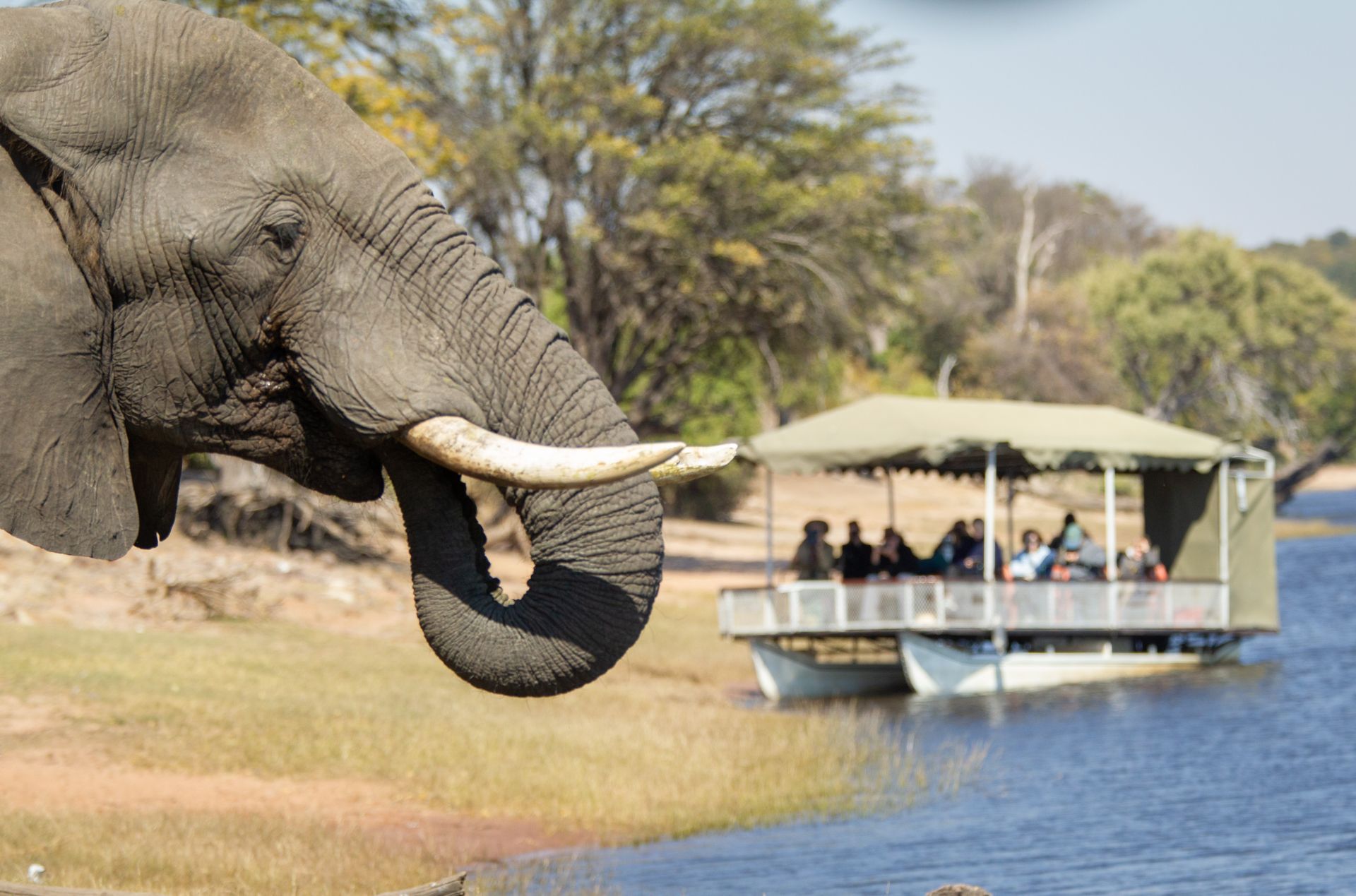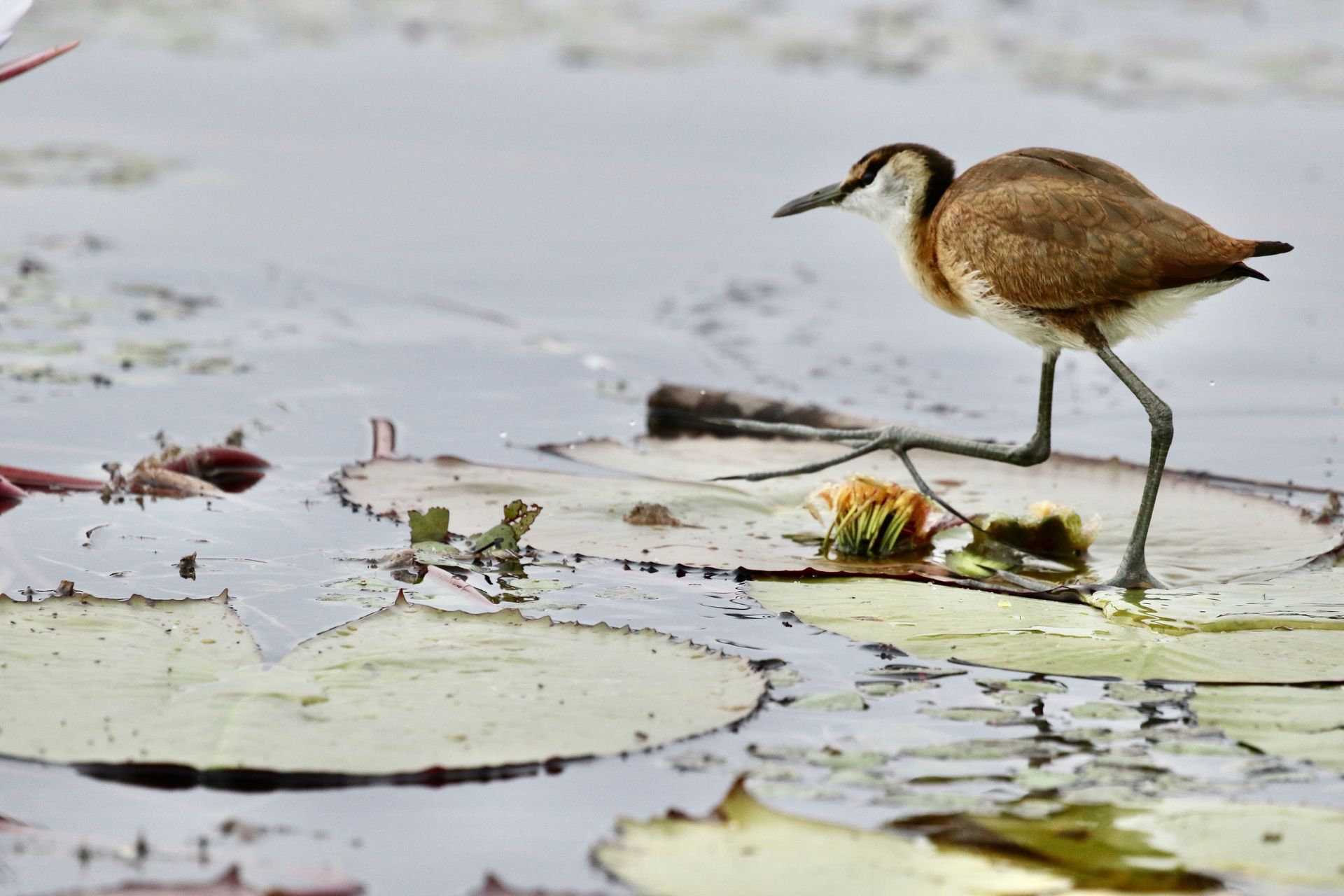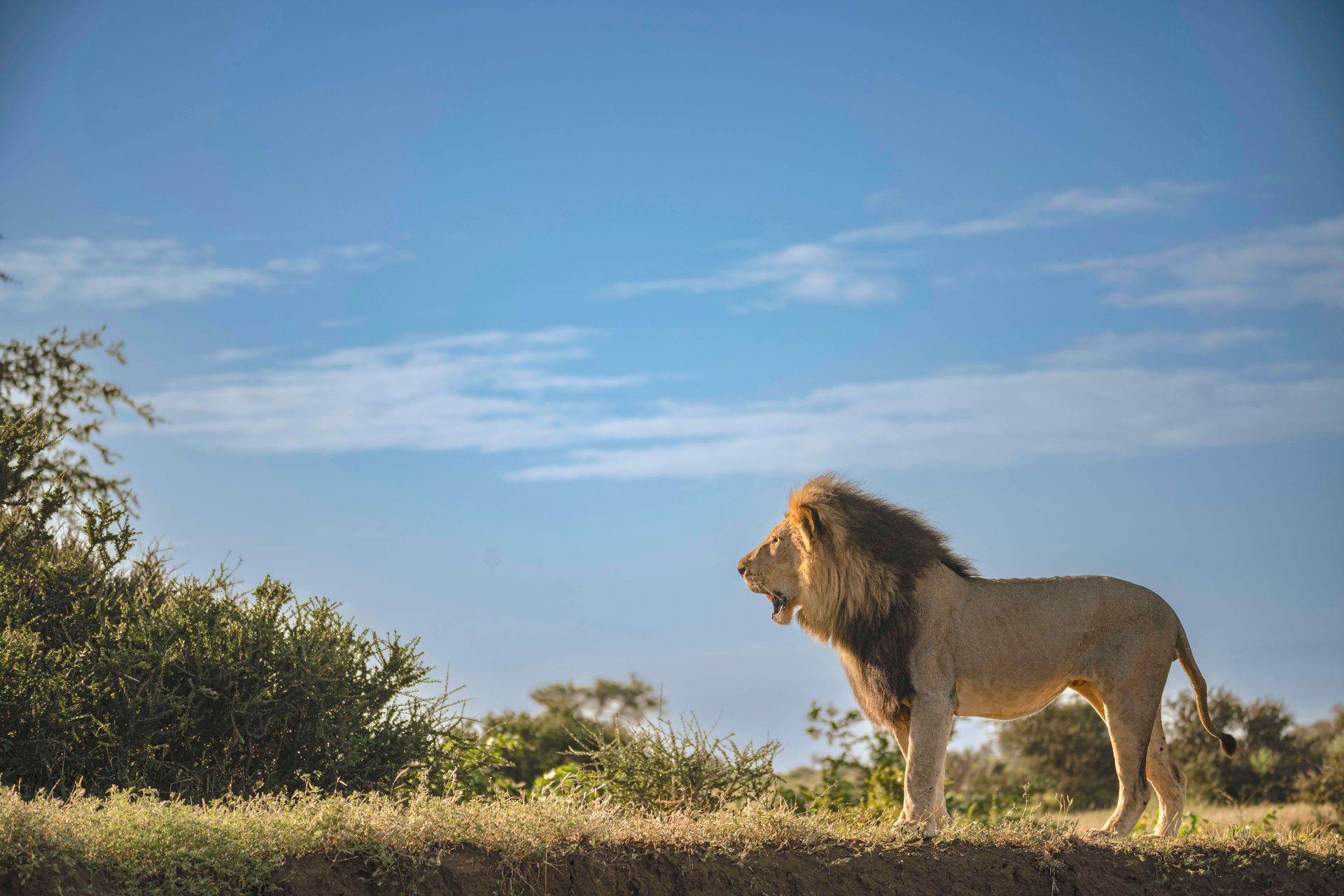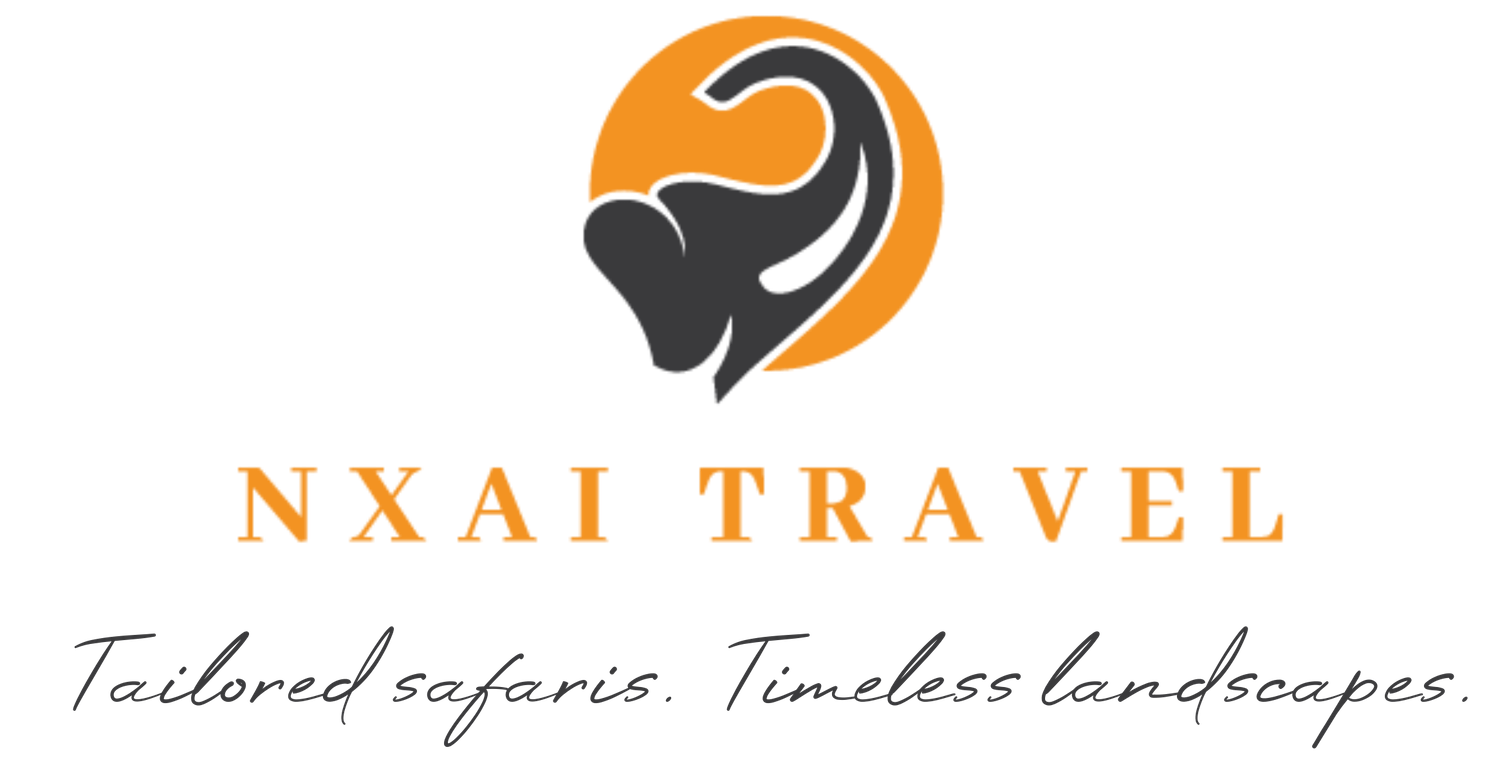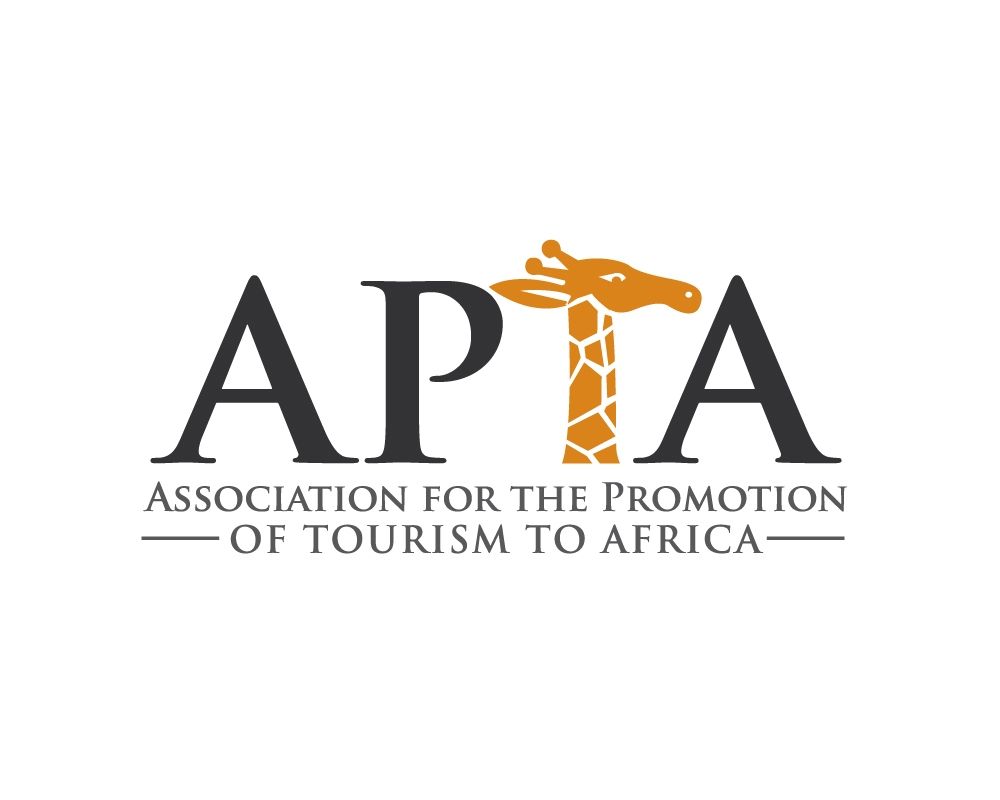Chobe
National Park
Chobe
National Park
Chobe
National Park
The elephant capital of Africa
Chobe National Park is Botswana’s original wildlife sanctuary – a place of legendary elephant herds, powerful predators and dramatic landscapes that shift with the seasons. Established in 1968, it remains one of the country’s most iconic and accessible safari destinations, stretching over 11,700 square kilometres of wilderness.
It’s often the first stop for travellers entering Botswana via Kasane or Victoria Falls, but it rarely feels like an introduction. Chobe delivers big from the very first game drive or river cruise. You might start your day with a lion sighting on the floodplains, watch a herd of elephants cross the Chobe River by mid-morning, and end the afternoon with a fish eagle’s call echoing over the water.
Whether by boat or open safari vehicle, Chobe is one of those rare destinations that offers variety, scale and spectacle in equal measure.
The elephant capital of Africa
Chobe National Park is Botswana’s original wildlife sanctuary – a place of legendary elephant herds, powerful predators and dramatic landscapes that shift with the seasons. Established in 1968, it remains one of the country’s most iconic and accessible safari destinations, stretching over 11,700 square kilometres of wilderness.
It’s often the first stop for travellers entering Botswana via Kasane or Victoria Falls, but it rarely feels like an introduction. Chobe delivers big from the very first game drive or river cruise. You might start your day with a lion sighting on the floodplains, watch a herd of elephants cross the Chobe River by mid-morning, and end the afternoon with a fish eagle’s call echoing over the water.
Whether by boat or open safari vehicle, Chobe is one of those rare destinations that offers variety, scale and spectacle in equal measure.
The elephant capital of Africa
Chobe National Park is Botswana’s original wildlife sanctuary – a place of legendary elephant herds, powerful predators and dramatic landscapes that shift with the seasons. Established in 1968, it remains one of the country’s most iconic and accessible safari destinations, stretching over 11,700 square kilometres of wilderness.
It’s often the first stop for travellers entering Botswana via Kasane or Victoria Falls, but it rarely feels like an introduction. Chobe delivers big from the very first game drive or river cruise. You might start your day with a lion sighting on the floodplains, watch a herd of elephants cross the Chobe River by mid-morning, and end the afternoon with a fish eagle’s call echoing over the water.
Whether by boat or open safari vehicle, Chobe is one of those rare destinations that offers variety, scale and spectacle in equal measure.
Why it stands out
Chobe is most famous for its elephants – and with good reason. The numbers are astonishing, particularly in the dry season when hundreds, sometimes thousands, gather at the river to drink, dust-bathe and cool off. Watching these giants move together through the floodplains is one of Africa’s great wildlife experiences.
Birdlife is another major draw. With more than 460 species recorded, from the unmistakable cry of the African fish eagle to the vivid flash of carmine bee-eaters in flight, Chobe offers world-class birding throughout the year. Wetland species, raptors, and migratory visitors all thrive in this rich and varied ecosystem.
Why it stands out
Chobe is most famous for its elephants – and with good reason. The numbers are astonishing, particularly in the dry season when hundreds, sometimes thousands, gather at the river to drink, dust-bathe and cool off. Watching these giants move together through the floodplains is one of Africa’s great wildlife experiences.
Birdlife is another major draw. With more than 460 species recorded, from the unmistakable cry of the African fish eagle to the vivid flash of carmine bee-eaters in flight, Chobe offers world-class birding throughout the year. Wetland species, raptors, and migratory visitors all thrive in this rich and varied ecosystem.
Why it stands out
Chobe is most famous for its elephants – and with good reason. The numbers are astonishing, particularly in the dry season when hundreds, sometimes thousands, gather at the river to drink, dust-bathe and cool off. Watching these giants move together through the floodplains is one of Africa’s great wildlife experiences.
Birdlife is another major draw. With more than 460 species recorded, from the unmistakable cry of the African fish eagle to the vivid flash of carmine bee-eaters in flight, Chobe offers world-class birding throughout the year. Wetland species, raptors, and migratory visitors all thrive in this rich and varied ecosystem.
Some background
Chobe National Park was officially established in 1968, making it Botswana’s first national park and one of the most ecologically diverse. It was created to protect the immense wildlife concentrations found along the Chobe River and its surrounding woodlands – particularly the region’s elephants, which are now among the largest populations anywhere in Africa.
The park covers almost 12,000 square kilometres and includes four very distinct ecosystems: the Chobe Riverfront in the north, the remote Linyanti wetlands in the northwest, the open plains and hills of Savute in the southwest, and the seasonal pans of Ngwezumba in the interior. Each area has its own rhythm, shaped by rainfall, flood cycles and the movement of animals.
In earlier decades, this region was impacted by hunting and ivory poaching, but strong conservation policies have allowed wildlife numbers to rebound dramatically. Today, Chobe plays a critical role in Botswana’s broader conservation network, linking wildlife corridors that stretch into Namibia, Zimbabwe and Angola.
Chobe is also closely tied to the development of photographic tourism in Botswana. It was here, along the riverfront, that many of the country’s early safari operations began. Its proximity to Kasane and Victoria Falls makes it a natural starting point for travellers – but its real magic lies in its raw, wild spaces, where nature still moves freely across ancient migratory paths.
Some background
Chobe National Park was officially established in 1968, making it Botswana’s first national park and one of the most ecologically diverse. It was created to protect the immense wildlife concentrations found along the Chobe River and its surrounding woodlands – particularly the region’s elephants, which are now among the largest populations anywhere in Africa.
The park covers almost 12,000 square kilometres and includes four very distinct ecosystems: the Chobe Riverfront in the north, the remote Linyanti wetlands in the northwest, the open plains and hills of Savute in the southwest, and the seasonal pans of Ngwezumba in the interior. Each area has its own rhythm, shaped by rainfall, flood cycles and the movement of animals.
In earlier decades, this region was impacted by hunting and ivory poaching, but strong conservation policies have allowed wildlife numbers to rebound dramatically. Today, Chobe plays a critical role in Botswana’s broader conservation network, linking wildlife corridors that stretch into Namibia, Zimbabwe and Angola.
Chobe is also closely tied to the development of photographic tourism in Botswana. It was here, along the riverfront, that many of the country’s early safari operations began. Its proximity to Kasane and Victoria Falls makes it a natural starting point for travellers – but its real magic lies in its raw, wild spaces, where nature still moves freely across ancient migratory paths.
Some background
Chobe National Park was officially established in 1968, making it Botswana’s first national park and one of the most ecologically diverse. It was created to protect the immense wildlife concentrations found along the Chobe River and its surrounding woodlands – particularly the region’s elephants, which are now among the largest populations anywhere in Africa.
The park covers almost 12,000 square kilometres and includes four very distinct ecosystems: the Chobe Riverfront in the north, the remote Linyanti wetlands in the northwest, the open plains and hills of Savute in the southwest, and the seasonal pans of Ngwezumba in the interior. Each area has its own rhythm, shaped by rainfall, flood cycles and the movement of animals.
In earlier decades, this region was impacted by hunting and ivory poaching, but strong conservation policies have allowed wildlife numbers to rebound dramatically. Today, Chobe plays a critical role in Botswana’s broader conservation network, linking wildlife corridors that stretch into Namibia, Zimbabwe and Angola.
Chobe is also closely tied to the development of photographic tourism in Botswana. It was here, along the riverfront, that many of the country’s early safari operations began. Its proximity to Kasane and Victoria Falls makes it a natural starting point for travellers – but its real magic lies in its raw, wild spaces, where nature still moves freely across ancient migratory paths.
What kind of safari to expect
Chobe is not a single experience – it’s a mosaic of different habitats, each offering its own style of safari. The park is divided into four main areas, and each has its own magic.
The Chobe Riverfront is the most accessible part of the park, and where most first-time visitors begin. Open safari vehicle game drives along the river’s edge often produce sightings of buffalo, elephant, lion and antelope in quick succession. River cruises are a highlight here too, bringing you eye-level with hippos, crocodiles and birds while elephants swim just metres away.
Linyanti, to the north-east, is a private concession where the Linyanti and Kwando Rivers meet. It’s wild, remote and known for exceptional predator sightings. This is one of the best places in Africa to see painted wolves (African wild dogs), especially during their denning season between June and September. Large herds of elephant and buffalo pass through, followed by lion, leopard and cheetah. The birding is superb between October and January, when summer migrants arrive in force.
Savute is steeped in safari lore. Its wide plains and marshes are home to intense predator-prey drama and large, powerful lion prides. The Savute Channel itself is a mystery – sometimes flowing, sometimes dry – and when water does appear, it transforms the region.
What kind of safari to expect
Chobe is not a single experience – it’s a mosaic of different habitats, each offering its own style of safari. The park is divided into four main areas, and each has its own magic.
The Chobe Riverfront is the most accessible part of the park, and where most first-time visitors begin. Open safari vehicle game drives along the river’s edge often produce sightings of buffalo, elephant, lion and antelope in quick succession. River cruises are a highlight here too, bringing you eye-level with hippos, crocodiles and birds while elephants swim just metres away.
Linyanti, to the north-east, is a private concession where the Linyanti and Kwando Rivers meet. It’s wild, remote and known for exceptional predator sightings. This is one of the best places in Africa to see painted wolves (African wild dogs), especially during their denning season between June and September. Large herds of elephant and buffalo pass through, followed by lion, leopard and cheetah. The birding is superb between October and January, when summer migrants arrive in force.
Savute is steeped in safari lore. Its wide plains and marshes are home to intense predator-prey drama and large, powerful lion prides. The Savute Channel itself is a mystery – sometimes flowing, sometimes dry – and when water does appear, it transforms the region.
What kind of safari to expect
Chobe is not a single experience – it’s a mosaic of different habitats, each offering its own style of safari. The park is divided into four main areas, and each has its own magic.
The Chobe Riverfront is the most accessible part of the park, and where most first-time visitors begin. Open safari vehicle game drives along the river’s edge often produce sightings of buffalo, elephant, lion and antelope in quick succession. River cruises are a highlight here too, bringing you eye-level with hippos, crocodiles and birds while elephants swim just metres away.
Linyanti, to the north-east, is a private concession where the Linyanti and Kwando Rivers meet. It’s wild, remote and known for exceptional predator sightings. This is one of the best places in Africa to see painted wolves (African wild dogs), especially during their denning season between June and September. Large herds of elephant and buffalo pass through, followed by lion, leopard and cheetah. The birding is superb between October and January, when summer migrants arrive in force.
Savute is steeped in safari lore. Its wide plains and marshes are home to intense predator-prey drama and large, powerful lion prides. The Savute Channel itself is a mystery – sometimes flowing, sometimes dry – and when water does appear, it transforms the region.
Things to do and see
Chobe’s activities are largely focused on game drives and river cruises or water-based activities where these are possible. Game drives take you into the heart of the action. Early morning and late afternoon outings often produce sightings of elephants, lions, leopards and more. The rhythm of the day changes with the seasons, and your guide will know just where to find the movement.
Chobe River cruises offer a different perspective. Drifting past elephant herds, watching hippos at eye level and photographing birds from the water is an unforgettable part of the experience. Sunset cruises, in particular, are a highlight – the light on the water, the silhouettes of animals along the shore and the quiet hum of the boat all combine to create pure safari magic.
For those who want to add a little more, day trips to Victoria Falls are easily arranged from Kasane. Just a short border crossing away, the Falls provide a breathtaking contrast to the slower pace of the bush – and the chance to stand in awe of one of the world’s greatest natural wonders.
Things to do and see
Chobe’s activities are largely focused on game drives and river cruises or water-based activities where these are possible. Game drives take you into the heart of the action. Early morning and late afternoon outings often produce sightings of elephants, lions, leopards and more. The rhythm of the day changes with the seasons, and your guide will know just where to find the movement.
Chobe River cruises offer a different perspective. Drifting past elephant herds, watching hippos at eye level and photographing birds from the water is an unforgettable part of the experience. Sunset cruises, in particular, are a highlight – the light on the water, the silhouettes of animals along the shore and the quiet hum of the boat all combine to create pure safari magic.
For those who want to add a little more, day trips to Victoria Falls are easily arranged from Kasane. Just a short border crossing away, the Falls provide a breathtaking contrast to the slower pace of the bush – and the chance to stand in awe of one of the world’s greatest natural wonders.
Why choose Chobe National Park
Chobe is home to the largest concentration of elephants on the planet, but it’s not just about numbers. It’s about proximity, scale and unforgettable encounters. This is where you’ll watch elephants swim across a river channel, where you’ll track lions in an open safari vehicle along floodplain tracks, where you’ll sit quietly on a boat as kingfishers flash past.
The birding is exceptional, with rare species appearing alongside familiar favourites. Predator sightings are reliable, and the variety of landscapes means there’s always something new around the next bend. Chobe is also uniquely positioned to combine seamlessly with Victoria Falls and Namibia’s Caprivi Strip, making it ideal for travellers wanting a rich, multi-country journey.
Whether it’s your first time on safari or your fifth, Chobe offers that special kind of safari experience that stays with you long after you’ve left – bold, beautiful, and unmistakably Botswana.
Things to do and see
Chobe’s activities are largely focused on game drives and river cruises or water-based activities where these are possible. Game drives take you into the heart of the action. Early morning and late afternoon outings often produce sightings of elephants, lions, leopards and more. The rhythm of the day changes with the seasons, and your guide will know just where to find the movement.
Chobe River cruises offer a different perspective. Drifting past elephant herds, watching hippos at eye level and photographing birds from the water is an unforgettable part of the experience. Sunset cruises, in particular, are a highlight – the light on the water, the silhouettes of animals along the shore and the quiet hum of the boat all combine to create pure safari magic.
For those who want to add a little more, day trips to Victoria Falls are easily arranged from Kasane. Just a short border crossing away, the Falls provide a breathtaking contrast to the slower pace of the bush – and the chance to stand in awe of one of the world’s greatest natural wonders.
Why choose Chobe National Park
Chobe is home to the largest concentration of elephants on the planet, but it’s not just about numbers. It’s about proximity, scale and unforgettable encounters. This is where you’ll watch elephants swim across a river channel, where you’ll track lions in an open safari vehicle along floodplain tracks, where you’ll sit quietly on a boat as kingfishers flash past.
The birding is exceptional, with rare species appearing alongside familiar favourites. Predator sightings are reliable, and the variety of landscapes means there’s always something new around the next bend. Chobe is also uniquely positioned to combine seamlessly with Victoria Falls and Namibia’s Caprivi Strip, making it ideal for travellers wanting a rich, multi-country journey.
Whether it’s your first time on safari or your fifth, Chobe offers that special kind of safari experience that stays with you long after you’ve left – bold, beautiful, and unmistakably Botswana.
Why choose Chobe National Park
Chobe is home to the largest concentration of elephants on the planet, but it’s not just about numbers. It’s about proximity, scale and unforgettable encounters. This is where you’ll watch elephants swim across a river channel, where you’ll track lions in an open safari vehicle along floodplain tracks, where you’ll sit quietly on a boat as kingfishers flash past.
The birding is exceptional, with rare species appearing alongside familiar favourites. Predator sightings are reliable, and the variety of landscapes means there’s always something new around the next bend. Chobe is also uniquely positioned to combine seamlessly with Victoria Falls and Namibia’s Caprivi Strip, making it ideal for travellers wanting a rich, multi-country journey.
Whether it’s your first time on safari or your fifth, Chobe offers that special kind of safari experience that stays with you long after you’ve left – bold, beautiful, and unmistakably Botswana.


